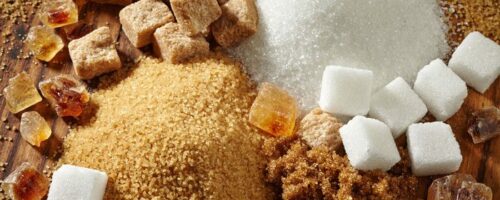
Jamaica
How is it produced?
A sugar plant can grow to be 15 feet tall and two inches wide. As the plant grows, it is surrounded by serrated edges that cut into exposed flesh as humans work the fields. A sugar plant grows approximately one inch per day for six weeks, and then takes between 9-18 months to ripen. Once the sugar cane is ready for reaping, it must be cut to its root and leaves chopped off. The sugar plant must be cut at exactly the right time, so that the quality of sucrose does not decline. Once the sugar cane is cut, the stalk is crushed to extract juices and the liquid is boiled and cooled to make sugar.
Describe the supply chain to the store shelf in Canada:
African slaves were the labor source on Caribbean sugar plantations for centuries. Since the abolition of slavery, impoverished Caribbeans work for extremely low wages to reap the sugar cane and process it in factories. From there, it is transported out of the Caribbean to globalized buyers, such as the distributors in Canada.
What is the power balance between the producer and seller?
There is an enormous power imbalance throughout the entire process of sugar production. Colonial power structures were the root of this commodity and still exist today. The owners of the sugar plantations have a lot of power, but the actual workers are impoverished. The workers suffer grueling conditions and long days without benefits for the owners to make big profits. The owners sell the product to distributors who sell it to the public.
Can you recommend changes to the system to improve the balance?
I believe that the entire system of sugar production has to be broken down to truly change the power imbalance. The reason for my position is that the sugar commodity originated as an ideal cash crop among British settler colonialists who wanted a profitable crop to export. These settler colonialists imported African slave labor and shaped the entire global economy by using forced labor to produce something they could sell at a high price. Today, there are just a few powerful companies that own the sugar plantations and the laborers are exploited, even though slavery has formally been abolished. For a solution, I would suggest the nationalization of sugar plantations to be owned by the governments with the profits shared among the people who live in these nations.
References/Resources:
Altman, I. (2007). The revolt of Enrique and the historiography of Early Spanish America. The Americas, 63(4), 587-614.
Axon, A. (2005, April). CBC big sugar: Documentary of the political history of the sugar industry. Retrieved from https://www.youtube.com/watch?v=PHh5odELpi4.
Barker, A. & Lowman, E. B. (2020). Settler colonialism. Global Social Theory. Retrieved from https://globalsocialtheory.org/concepts/settler-colonialism/
Beckles, H. (1985). Plantation production and proto–white slavery: White indentured servants and the colonization of the English West Indies. The Americas, 41, 21-45.
Burnard, T. & Morgan, K. (2001). The dynamics of the slave market and slave purchasing patterns in Jamaica, 1655 -1788. William and Mary Quarterly 58(1), 205-228.
De Barros, J., Diptee, A., & Trotman, D. V. (2006). Beyond fragmentation: Perspectives on Caribbean history. Princeton, NJ: Markus Wiener Publishers.
Edmonds, K. (2015). An elusive independence: Neocolonial intervention in the Caribbean. International Socialism, 146, 124-142.
Ellwood, W. (2015). Globalization: Buying and selling the world (4th ed.). Between the Lines.
Forte, M. C. (2013). Carib identity, racial politics, and the problem of indigenous recognition in Trinidad and Tobego. In Who Is an Indian? (pp. 172-193). Toronto, ON: University of Toronto Press.
Handler, J. (1965). Some aspects of work organization on sugar plantations in Barbados. Sociological Abstracts, 4(1), 16-38.
Harrison, J. (2011). The colonial legacy and social policy in the British Caribbean. In J. Midgley & D. Piachaud (Eds.), Social Policy and the British Imperial Legacy (pp. 55-70). Northampton, MA: Edward Elgar Publishing.
Mintz, S. W. (1986). Chapter 1: Food, sociality and sugar. In Sweetness and power: The place of sugar in modern history. Penguin.

